Bhagvan Krishna, the eighth avatar of Lord Vishnu, the supreme cosmic preserver, is one of the most revered deities in Hinduism. Bhagvan Krishna is regarded as a complete and eternal incarnation of the Lord Vishnu.
In other blogs I introduce the deities by going through their forms, and attributes, and then come to their teachings, and understanding them better, here, I feel I should be writing first about Shri Krishna’s teaching first to understand his childhood, and his personality better, hence, let’s cover Bhagvan Krishna’s teachings and philosophy first:
- Shree Krishna’s Teachings and Philosophy
- Historical and Scriptural Background
- Bhagvan Krishna as the Svayam Bhagavan
- Divine Qualities of Krishna
- Forms of Bhagvan Krishna
- Krishna Rukmini
- Krishna Radha
- Gopis of Vrindavan
- Symbols Associated with Krishna
- Worship and Devotion to Krishna
- Forms of Devotional Worship (Bhakti)
Shree Krishna’s Teachings and Philosophy
Bhagvan Krishna’s teachings in the Bhagavad Gita offer a timeless wisdom for living a meaningful and balanced life. His wisdom addresses duty, devotion, action, knowledge, and surrender, helping individuals navigate challenges with clarity and purpose.
Dharma
Bhagvan Krishna teaches that Dharma is about doing the right thing with sincerity, without being attached to success or failure. Everyone has a duty (Swadharma) based on their role in life, and fulfilling it is essential. However, Krishna also emphasizes Nishkama Karma—acting without expecting rewards. True peace comes from focusing on effort, not outcomes. Beyond personal duty, Krishna reveals that the highest Dharma is surrendering to him, as he protects righteousness and restores balance whenever needed. His teachings remind us that Dharma is about living with truth, selflessness, and devotion.
Bhakti Yoga
Bhagwan Krishna teaches that pure devotion (Bhakti) is the highest path to liberation. True Bhakti is about loving and trusting Him completely, knowing that He is always there to guide and protect. It is not just about rituals but about a heart filled with faith and surrender, seeing Krishna as the eternal well-wisher and source of all love.
Karma Yoga
Krishna teaches that selfless action—working without attachment to results—leads to spiritual growth. When we perform our duties with dedication but without selfish desires, it purifies the mind and brings inner peace. This mindset helps us stay calm in success and failure, understanding that work itself can be an act of worship when done with the right intention.
Jnana Yoga
Bhagvan Krishna teaches Jnana Yoga (path of knowledge) as the path of wisdom and self-realization. It is about understanding the difference between the eternal soul (Atman) and the temporary body, realizing that we are not this body but the divine consciousness within. True knowledge comes from seeing beyond illusion (Maya) and recognizing the oneness of the self with the Supreme (Brahman). Lord Krishna explains that wisdom leads to liberation, as the enlightened person remains unshaken by joy or sorrow, detached from material desires, and sees all beings as equal. However, knowledge alone is not enough—it must be combined with devotion and action for true spiritual growth.
Sharanagati
One of Krishna’s most profound teachings is complete surrender to Him with trust and devotion. He assures that those who take refuge in Him are freed from all fears, sins, and karmic bondage. Surrender does not mean escaping responsibility—it means trusting Lord Krishna while performing one’s duties with faith. When we let go of worries and rely on Him, He guides our path and removes all obstacles. True surrender brings inner peace, freeing one from doubt, fear, and the cycle of karma.
These teachings offer a roadmap to a fulfilling life, encouraging people to act with righteousness, devotion, selflessness, wisdom, and trust in the Divine.
Historical and Scriptural Background
Lord Shree Krishna was born over 5,000 years ago in the ‘Dwapara Yuga’ (the running Yuga before Kali Yoga) in Mathura.
Lord Krishna was the son of Devaki and Vasudeva but was raised by Yashoda and Nanda. This was done to protect Krishna from Kansa, who had been warned by a prophecy that Devaki’s eighth child would kill him. In case you are wondering if this happened, yes it happened. Bhagvan Krishna ended up killing Kansa.
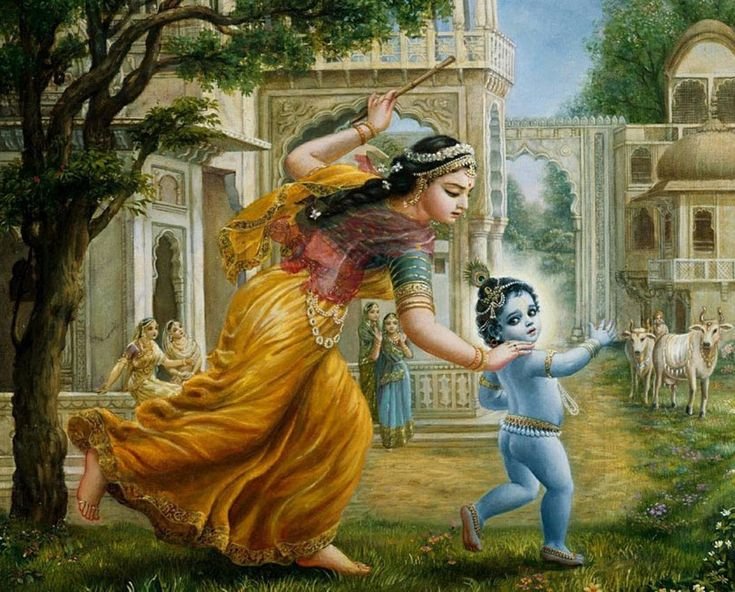
Lord Sri Krishna’s life, teachings, and divine leelas are extensively covered in various sacred Hindu scriptures, including the Mahabharata, Srimad Bhagavatam (also known as Bhagavata Purana), Vishnu Purana, and Harivamsa—an appendix to the Mahabharata.
The Bhagavad Gita, the most widely known sacred scripture of Hinduism, is a spiritual revelation of the timeless wisdom regarding the essence of dharma, devotion, self-realization (&much more) given by Krishna to Arjuna on the battlefield of Kurukshetra.
Bhagvan Krishna as the Svayam Bhagavan
Okay, as you know and as I have been mentioning in my blogs, there are many traditions within Hinduism. The tradition of Vaishnavism is a tradition of worshipping Lord Vishnu and his avatars, however, even in Vaishnavism, there are sub-categories of the traditions.
I will try to make it more simple. We know that in Vaishnavism Lord Vishnu is the Supreme Being (Svayam Bhagavan) and the ultimate reality (Para Brahman). All other deities, including Shiva and Brahma, are seen as either his expansions, devotees, or subordinate deities.
However, even within Vaishnavism, there are different, for the lack of a better word, different schools, different interpretations, or different categories of Vaishnavism.
In Sri Vaishnavism tradition, Lord Vishnu is the Supreme God and Bhagvan Krishna is an avatar of Lord Vishnu. Similarly, there is a tradition known as the Gaudiya tradition, where Lord Sri Krishna is considered the Svayam Bhagavan, the Supreme Being who encompasses all divine aspects. Unlike other incarnations of Lord Vishnu, Lord Shree Krishna is regarded as the complete and eternal manifestation of the Divine (Brahman – the supreme absolute reality).
Here, even Lord Vishnu is considered an expansion of Krishna, not the other way around. Meaning that Krishna exists first, and from Krishna, different forms of Gods, including Lord Vishnu manifest.

Divine Qualities of Krishna
If you are a Hindu, it is not uncommon to hear the Leelas of Bhagvan Krishna here let’s his divine qualities from Leelas to him passing down the knowledge of Yoga through the Bhagavad Gita and much more:
Leela Purushottama
Bhagvan Krishna is known as the divine performer, the master of Leela (divine play). Every aspect of his life, from his childhood mischief of stealing butter (Makhan Chor) to his playful moments in Vrindavan, was not just for joy but carried deeper spiritual meanings. His strategic wisdom in battle, his enchanting flute, and his playful interactions with devotees were all part of his divine plan—teaching the world about love, righteousness, and devotion in the most captivating way.
Yogeshwara
Bhagvan Krishna is revered as Yogeshwara, the ultimate guide on the path of yoga. His teachings in the Bhagavad Gita offer a spiritual roadmap for overcoming challenges, mastering the mind, and attaining self-realization. True yoga, as he explains, is not just about physical postures (asanas) but a way of life—one that balances devotion (Bhakti Yoga), wisdom (Jnana Yoga), and selfless action (Karma Yoga). Through these paths, Krishna shows how to live with purpose, inner peace, and divine connection.
Madhurya Bhagavan
Bhagvan Krishna’s interactions with his devotees, especially the Gopis of Vrindavan and Radha, symbolize the highest form of pure, selfless love. His divine presence is filled with unmatched sweetness and charm, drawing devotees toward him in deep, unconditional devotion. This Madhurya Bhava (divine sweetness) represents the deepest and most personal bond between Krishna and his devotees—a love so pure that it goes beyond worldly desires, dissolves all sense of self, and fills the heart with the eternal joy of being one with him.
Paripurna Avatar
Bhagvan Krishna is described as the full and complete incarnation of Lord Vishnu, possessing all six divine attributes in their highest form—strength, knowledge, wealth, beauty, fame, and detachment. Whether as a child stealing butter, a warrior defeating demons, or a divine teacher guiding humanity, he embodies every aspect of the Supreme Lord Vishnu. There is no aspect of divinity missing in Krishna; he is the perfect and absolute divine personality.
Forms of Bhagvan Krishna
Our Sanatan Dharma is very rich in that it allows devotees to connect with a god that resonates with them. I will get you in a minute on why I am writing this.
Bhagvan Krishna represents different forms and each form of Krishna refelcts a different divine aspect. Let’s cover these:
Bala Krishna
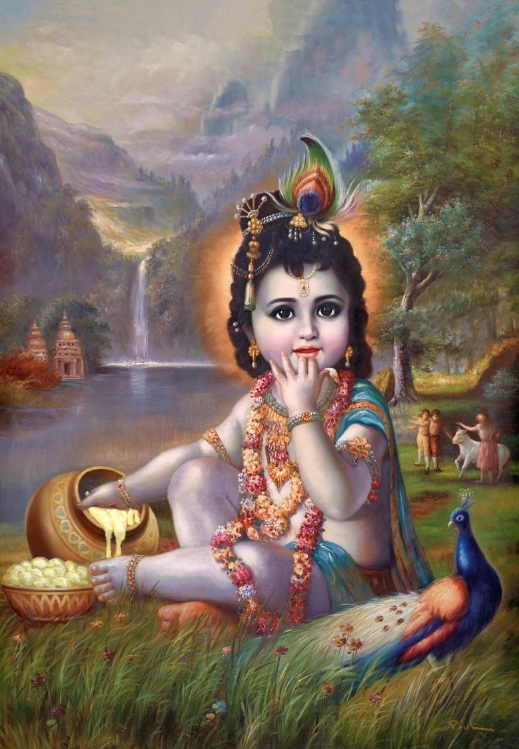
Bala Krishna, also known as Makhan Chor (Butter Thief), is the adorable child form of Bhagvan Krishna, loved for his innocence, mischief, and charm. Devotees delight in stories of baby Krishna stealing butter from village homes (more on “Why Krishna Stole Butter” in a separate blog). This playful form of Krishna symbolizes divine joy, purity, and unconditional love. Many worship Bala Krishna as Laddu Gopal, offering sweets and caring for him just like their own child, experiencing a deep, loving bond with the divine.
Gopala Krishna
Gopala Krishna, the cowherd of Vrindavan, is the protector of cows and the beloved of the Gopis. With the enchanting melody of his flute, he captivated hearts and performed the Rasa Leela, a divine dance symbolizing the soul’s longing to unite with God. This form of Krishna embodies pure love, devotion, and the bliss of surrendering to the divine. As a cowherd, Krishna also reflects his deep connection with nature and dharma, reminding us of the harmony between the divine, creation, and all living beings.
Dwarka Krishna
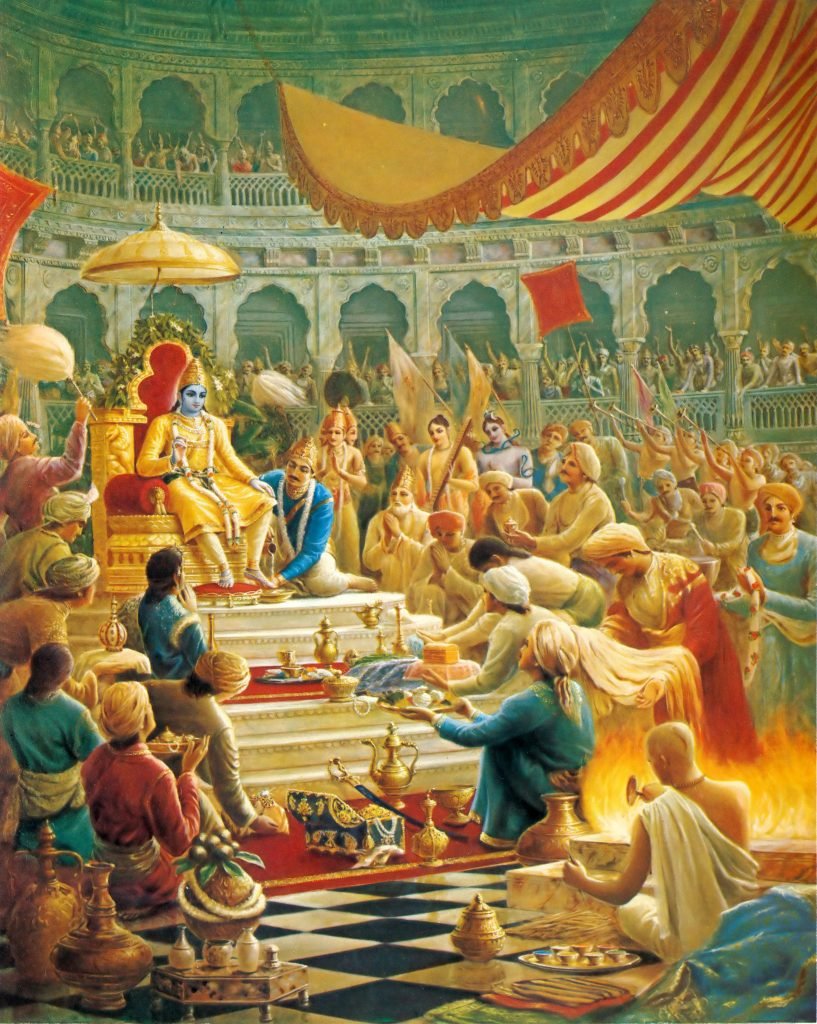
Dwarka Krishna is Bhagvan Krishna in his royal form, ruling as the wise and just King of Dwarka. After leaving Vrindavan, he built the grand city of Dwarka, where he governed with fairness and upheld dharma (righteousness). Unlike his playful days in Vrindavan, here Krishna is portrayed as a strategist, statesman, and protector of justice. He married Rukmini and played a crucial role in guiding the world through divine wisdom and righteous leadership. His rule in Dwarka symbolizes strength, responsibility, and the ideal way to lead with fairness and wisdom.
Parthasarathi
Parthasarathi, the Charioteer of Arjuna. During the great war of Mahabharata, Krishna took on the role of Parthasarathi and delivered the timeless wisdom of the sacred Bhagavad Gita. In this form, he does not fight but guides Arjuna on duty, righteousness (dharma), and devotion. This form of Krishna represents spiritual wisdom, selfless service, and the importance of fulfilling one’s duty without attachment.
Jagannath
Jagannath, meaning “Lord of the Universe,” is a unique and deeply revered form of Bhagvan Krishna worshipped in Puri, Odisha. In this form, Krishna is accompanied by his brother Balabhadra (Balarama) and sister Subhadra. Jagannath is closely linked with devotion, surrender, and divine love. The Rath Yatra (Chariot Festival) celebrates his immense love for his devotees as the deity is taken on a grand procession, drawing millions of people to honor him. Unlike other forms of Krishna, Jagannath represents the formless, all-encompassing aspect of Krishna as the Supreme Lord of the Universe, beyond any specific shape or form.
Now coming back to me mentioning that Hinduism allows devotees to connect with a god that resonates with them personally. Here, these different forms of Lord Shree Krishna allow devotees to connect with Krishna in a way that resonates with them.
From all that we’ve explored till now, you must have been aware that Krishna teaches us to walk the path of dharma, devotion, surrender, and selfless service. We’ve seen how deeply Krishna connects with his devotees and the immense love he has for them. Those who follow this path are blessed with Krishna’s divine love, experiencing the transformative power (in every area of one’s life) of his guidance and divine grace.
Now, let’s explore Bhagvan Krishna’s three most widely known and significant bonds: his chief queen Rukmini (an incarnation of Lakshmi Mata), his beloved Radha, and the devoted Gopis of Vrindavan.
Krishna Rukmini
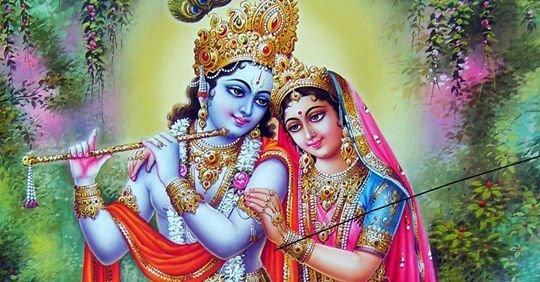
Goddess Rukmini, an incarnation of Goddess Lakshmi, is Krishna’s chief queen in Dvārakā. She embodies devotion rooted in duty and righteousness (Vaidhi Bhakti)—a love that follows the principles of dharma. Her love is deep, patient, and filled with respect, just like Lakshmi’s eternal devotion for Vishnu.
Krishna Radha
Radha is the purest form of devotion (Bhakti) and Krishna’s own divine energy (Hladini Shakti)—the power that brings Him joy, love, and sweetness. She is not separate from Him—she is His own love, playfulness, and bliss in a living form. Radha’s love is beyond marriage, beyond rules, and beyond material emotions—it is eternal, spiritual, and completely selfless. She represents the highest love for Krishna, where nothing else matters but Him.
Gopis of Vrindavan
The Gopis (cowherd maidens) of Vrindavan are Krishna’s most dedicated devotees. Among them, Radha is the highest. The Bhāgavata Purāṇa (10th Canto) describes their love as the purest and most selfless form of devotion (Madhurya Bhakti) marked by complete surrender. They leave everything behind for Krishna, showing that true love means placing God above all else.
Symbols Associated with Krishna
Bhagvan Krishna deeply symbolizes bansuri, peacock feathers, cow, lotus and conch. We covered Lotus and Conch on Lord Vishnu as well and you might be wondering how come it is also of Bhagvan Krishna’s. Bhagvan Krishna is an incarnation of Lord Vishnu, and essentially the message that Lord Vishnu is leaving behind us from these two symbols, Bhagvan Krishna is telling us the same, let’s explore the deep spiritual meaning behind these symbols:
Bansuri
Krishna Ji’s flute (Bansuri) is one of his most iconic symbols. Bansuri’s divine melody is said to enchant not just humans but also animals, trees, and even the elements of nature, drawing all beings toward him in love and devotion.
The flute is hollow, symbolizing the need to empty ourselves of ego, pride, and attachments so that divine grace can flow through us. Just as Krishna fills the flute with his music, surrendering to him allows our lives to be filled with his presence and love.
Peacock Feather
Krishna is often seen with a peacock feather in his crown, which symbolizes:
- Divine beauty and charm – Just as the peacock is known for its majestic beauty, Krishna’s presence is enchanting and full of divine grace.
- Harmony with nature – Krishna’s love for nature is reflected in the feather, reminding us of the importance of living in balance with the world.
Cow
Cows hold a special place in Krishna’s life, as he was a cowherd (Gopala) in Vrindavan. The sacred cow (Gau Mata) symbolizes:
- Motherly love and nourishment – Just as cows provide milk to sustain life, Krishna nurtures and protects his devotees with unconditional love.
- Prosperity and dharma – In Hinduism, the cow represents abundance, dharma, and non-violence. Krishna’s deep care for cows teaches us to respect and protect all living beings while following dharma and practicing non-violence. By doing so, we invite true abundance into our lives—one that goes beyond material wealth
Lotus
By now, you know better than me, that the Padma (lotus) is a sacred symbol in Hinduism and the supreme cosmic preserver Lord Vishnu symbolizes it, so does Lord Brahma and so does Bhagvan Krishna. It represents:
- Spiritual purity – The lotus grows in muddy water but remains untouched by impurity, just like Krishna, who lived in the material world but was never affected by it.
- Detachment – Just as water rolls off lotus petals, Krishna teaches us to live in the world without being attached to material desires.
- Divine consciousness – The unfolding petals of the lotus symbolize spiritual awakening, just as coming closer to Krishna awakens our inner consciousness and guides us on the path to enlightenment.
Conch
Same as the Lotus, Lord Vishnu also symbolized Shankha, and Bhagvan Krishna, also symbolized Shankha carrying a deep spiritual meaning. The shankha (conch) is associated with divine energy and cosmic creation. Krishna’s conch, known as Panchajanya, represents:
- The primordial sound (Om) – The sound of the conch resonates with the vibrations of the universe, signifying the creation and divine presence of Bhagvan Krishna, Lord Vishnu.
- Victory of righteousness – The conch is blown in times of war to announce the triumph of dharma (righteousness) over adharma (unrighteousness). Krishna’s conch symbolizes his role as the protector of dharma.
Worship and Devotion to Krishna
Krishna is worshiped with immense love and devotion by millions of people worldwide. His followers express their faith through temple visits, sacred festivals, and devotional practices that bring them closer to him.
Vrindavan, Mathura, and Dwarka are sacred tirthas (holy places) where devotees go to connect with Krishna, surrender to Him, and immerse themselves in His divine presence. Mathura, His birthplace, and Vrindavan, where He performed His childhood pastimes, are filled with temples and devotional kirtans. Dwarka, His majestic kingdom, is home to the revered Dwarkadhish Temple.
Festivals Celebrating Krishna
Krishna Janmashtami
Krishna Janmashtami (Krishna’s birthday) is one of the most important Hindu festivals. Devotees fast, pray, sing bhajans (devotional songs), and enact Krishna’s childhood pastimes. At midnight, Krishna’s birth is celebrated with great enthusiasm in temples and homes with joyous celebrations, symbolizing Krishna’s arrival in our hearts.
Govardhan Puja
This festival honors Krishna’s lifting of Govardhan Hill to protect the villagers of Vrindavan from torrential rains. Devotees offer a grand feast (Annakut) to Krishna, expressing gratitude and faith in His divine shelter, reminding us that true protection comes from surrendering to Him.
Rath Yatra
Rath Yatra, as mentioned above is celebrated at the Jagannath Temple in Puri and now also across various parts of the world, this festival features a grand procession where Krishna, Balarama, and Subhadra are placed on massive chariots and pulled through the streets by thousands of devotees signifying their deep longing to bring Krishna into their hearts and lives.
Forms of Devotional Worship (Bhakti)
Bhakti (devotional worship) is the most powerful way to connect with Krishna and receive His grace. Bhakti is an expression of love and surrender, bringing joy, peace, and spiritual fulfillment. There are many ways to practice bhakti, each deepening a devotee’s bond with Krishna:
Bhajan and Kirtan
Bhajan and Kirtan are not just songs; they are an outpouring of love for Krishna. When devotees sing His names and glories with sincerity, their minds become absorbed in Him, dissolving distractions and worldly worries. The vibrations of Krishna’s holy names cleanse the heart, creating a sacred space where His presence can be truly felt.
The rhythmic chanting, combined with music, clapping, and dancing, awakens bhava (deep devotional emotion), drawing Krishna closer to the devotee. As Krishna Himself promises in the Bhagavad Gita (9.14), “Always chanting My glories, striving with great determination, and bowing down before Me, they worship Me with devotion.” By engaging in Kirtan, devotees fulfill this promise, experiencing divine joy and strengthening their personal relationship with Him.
In that moment of surrender, the boundaries between the devotee and Krishna fade—what remains is pure love, where Krishna is no longer just a deity but the very essence of one’s heart and soul.
Japa
Japa (mantra chanting) is the meditative practice of chanting Krishna’s holy names to connect with Bhagvan Krishna, a simple yet very powerful way to purify the mind, heart and to connect with Bhagvan Krishna. By repeatedly chanting mantras such as the ‘Hare Krishna Maha Mantra’:
Hare Krishna, Hare Krishna, Krishna Krishna, Hare Hare
Hare Rama, Hare Rama, Rama Rama, Hare Hare
devotees immerse themselves in Krishna’s divine presence. This sacred mantra is not just a string of words—it is spiritually potent, carrying Krishna’s energy and grace. Chanting with sincerity removes negative thoughts, calms the mind, and fills the heart with peace and devotion. Over time, Japa deepens one’s connection with Krishna, making His presence feel closer in daily life.
Even a few minutes of Japa each day can bring immense spiritual benefits, transforming one’s consciousness and leading to inner joy and fulfillment.
Please note that you can chant other Krishna mantras such as ‘Om Namo Bhagavate Vasudevaya’ if you prefer them or align with them more and that it is not compulsory to chant the Hare Krishna Maha Mantra as the only mantra (which some people seem to be confused with). Nothing is forceful and compulsory in our rich and flexible Sanatana Dharma.
Puja and Arati
Puja and Arati are sacred rituals where devotees express love and devotion to Krishna through offerings. Lamps, flowers, incense, and food (prasad) are humbly presented, symbolizing surrender, gratitude, and the desire to serve Him.
Arati, performed with a lit lamp in circular motions, represents the removal of darkness from the heart, inviting Krishna’s divine light. The food offered to Him is an act of surrender, recognizing that everything ultimately belongs to Krishna. Once accepted by Him, it transforms into prasad, infused with His blessings, and is later shared among devotees—nourishing both body and soul.
Through these rituals, devotees cultivate a personal connection with Krishna, experiencing His presence and grace in their daily lives.
Reading Scriptures
Sacred texts like the Bhagavad Gita and Bhagavata Purana are not just ancient writings—they are Krishna’s direct words and pastimes, filled with divine wisdom. The Bhagavad Gita teaches dharma (righteous living), devotion, surrender, self-less action, and the path to liberation, while the Bhagavata Purana reveals Krishna’s loving nature through His miraculous pastimes.
By reading and reflecting on these scriptures, devotees gain clarity in life, strengthen their faith, and develop a deeper relationship with Krishna. These teachings not only help one to connect and develop a deep relationship with Krishna but they also serve as a guiding light, helping devotees navigate challenges while staying connected to their spiritual purpose.
You don’t have to read a whole book, even a few verses a day can transform the mind and bring one closer to Krishna’s grace.
Practicing bhakti in any form brings devotees closer to Krishna, filling their lives with divine love, peace, and fulfillment. Please also note that no single form of Bhakti is superior compared to others and that every form of Bhakti is superior. If you are inclined more towards reading the Scriptures of Bhagvan Krishna than doing Bhajan and Kirtan, that is superior to you and you can freely engage in it without worrying about the other forms.
At the moment, Bhagvan Krishna’s influence has extended beyond Hinduism worldwide. His teachings are embraced by seekers of truth and spirituality across various parts of the world.
Bhagvan Krishna is a living presence for millions of devotees. His divine love, wisdom, and teachings continue to guide people on the path of spirituality. Whether through devotion, philosophy, or meditation, Krishna remains an eternal source of bliss and enlightenment for seekers around the world.
If you found this blog insightful, dive deeper into Hinduism’s timeless wisdom by exploring more articles on our website!
Read Next:
30 Powerful “Bhagavad Gita As It Is” Quotes That Will Transform Your Life
The Bhagavad Gita, the “Song of God,” the one of the most popular holy books…
Hindu Om Symbol (ॐ): A Complete Guide to Its Meaning and Spiritual Power
The Hindu Om Symbol (ॐ) is far more than a sign; in Hinduism, it’s a…
27 Nakshatras in Vedic Astrology: A Complete Guide
In Vedic astrology (known as Jyotisha), the sky is divided into 27 Nakshatras or lunar…
7 Core Beliefs of Hinduism
Hinduism, the world’s oldest and the most diverse living religion doesn’t revolve around a single…
What is Sanatana Dharma?
Hinduism, the religion of over 1 billion population is the oldest religion, and calling Hinduism…
Sanchita Karma: The Invisible Record Shaping Your Destiny
Have you ever wondered why some people attract opportunities, partners, and income with far fewer…
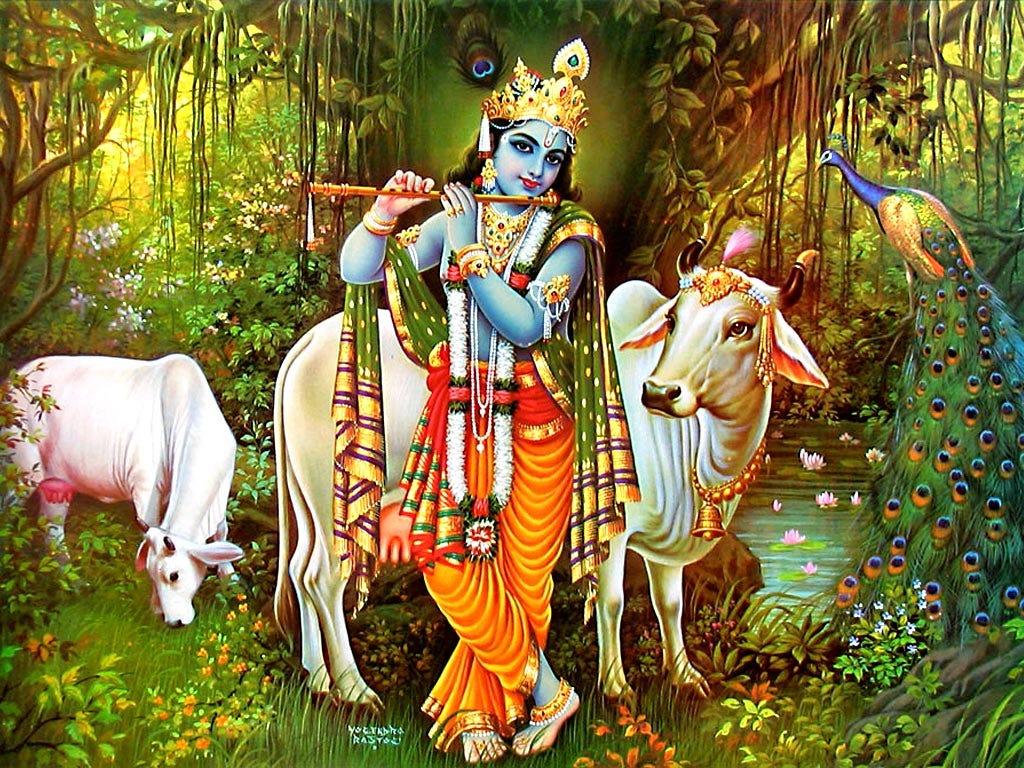

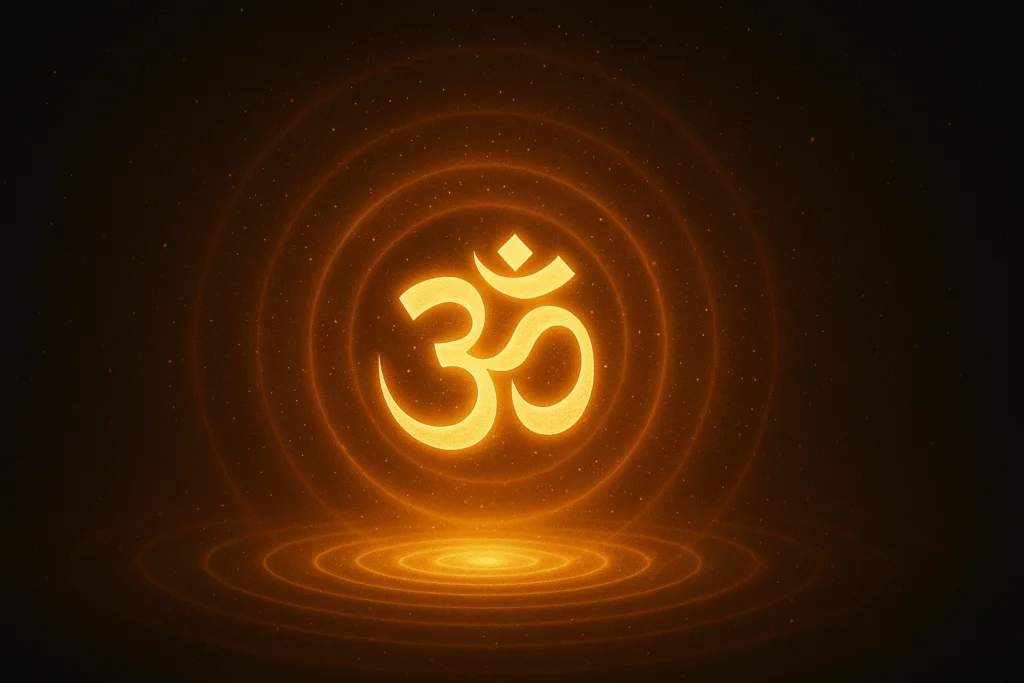


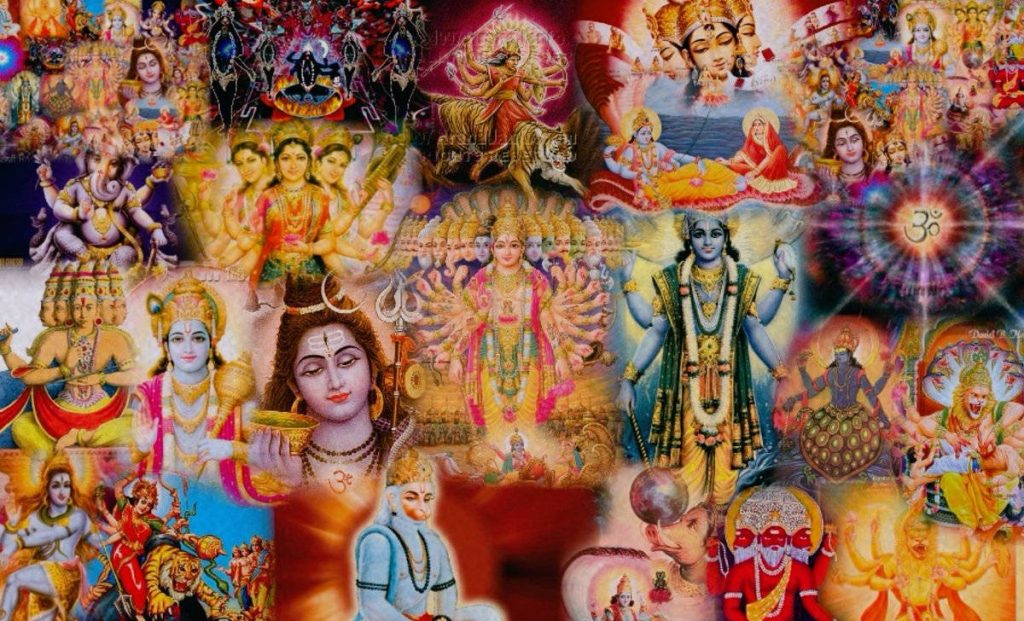
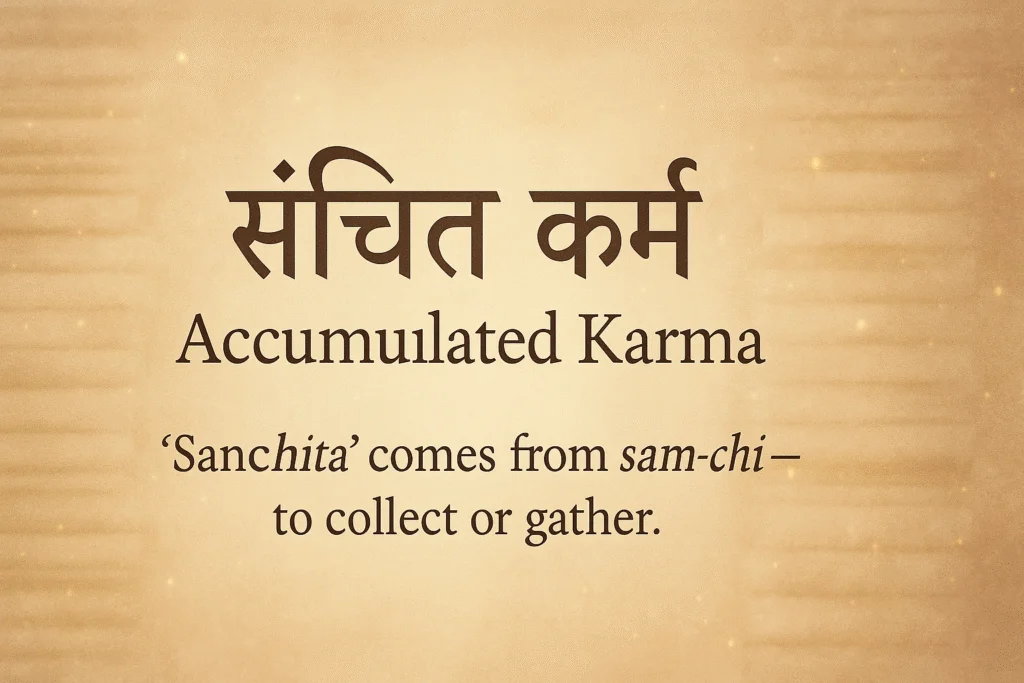
Leave a Reply